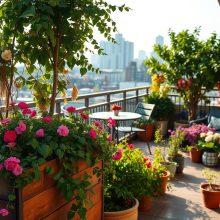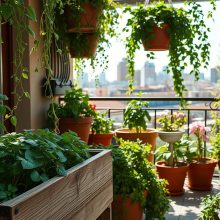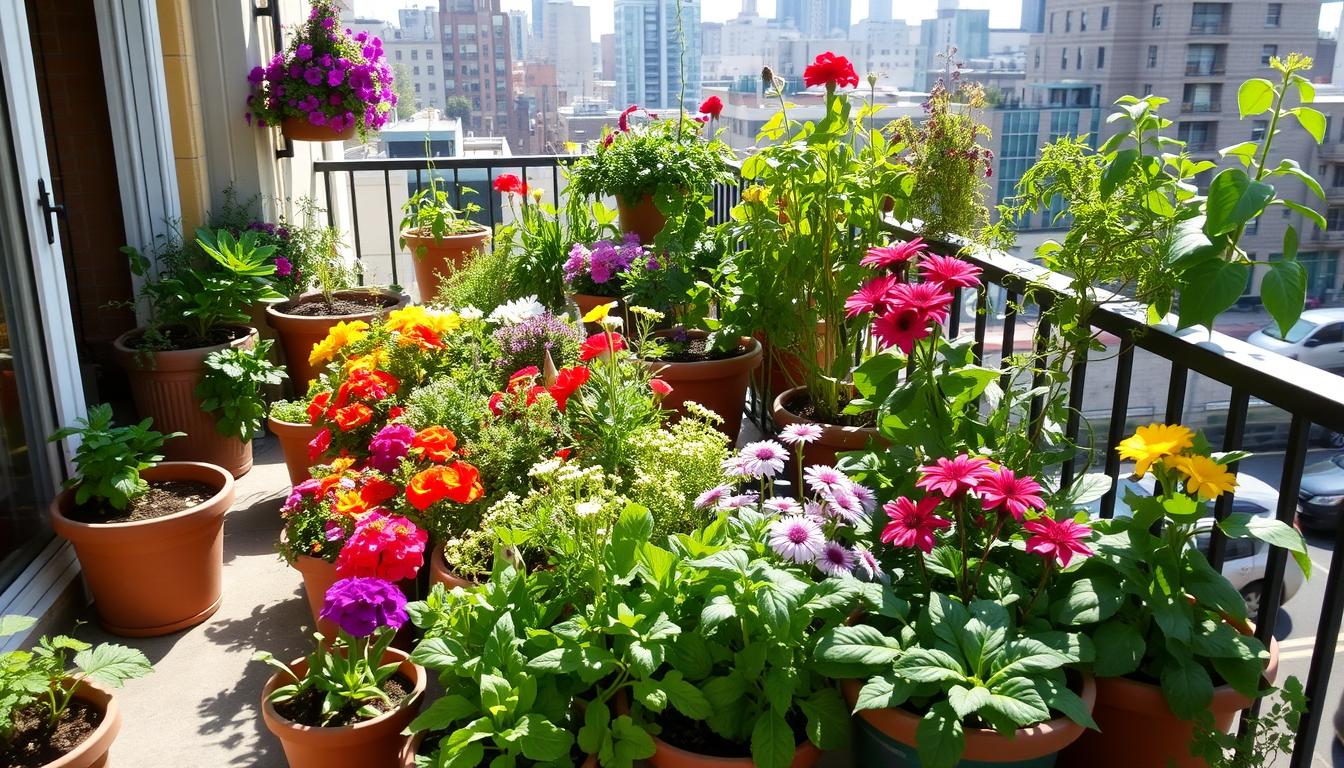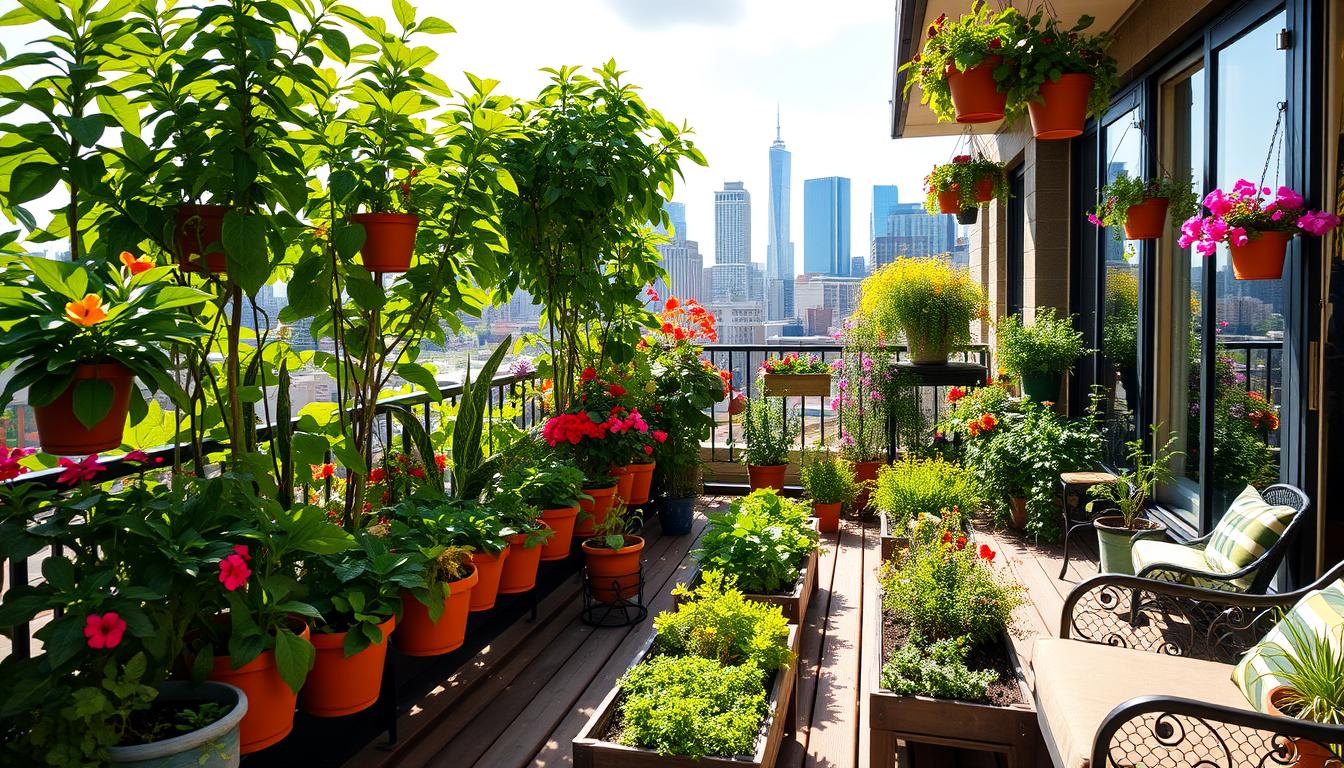Best Plants for Balconies: Top Choices for Urban Gardens
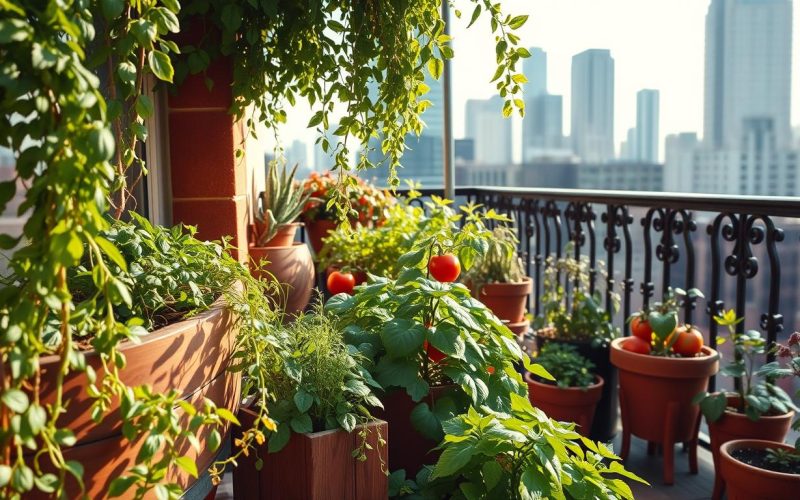
Urban dwellers are turning small balconies into green oases. They use creative gardening techniques. Even tiny spaces can become beautiful gardens with the right plants and design.
Choosing the right plants for balconies depends on your urban setting. Things like sunlight, wind, and space are key. They help decide which plants will do well in your garden.
Urban gardening is a great way to connect with nature, even in small spaces. It’s perfect for both experienced gardeners and beginners. Balcony gardening lets you create beauty and calm right outside your home.
Key Takeaways
- Urban balconies can be transformed into productive green spaces
- Careful plant selection is critical for success
- Sunlight and space constraints require strategic gardening approaches
- Balcony gardens provide mental health and aesthetic benefits
- Even small spaces can support diverse plant varieties
Understanding the Importance of Balcony Plants
Urban gardening has changed how city folks see green spaces. It’s a creative way to add nature to small living areas. Balcony plants do more than look good – they offer many benefits for city folks wanting to connect with nature.
City areas often have little green space. Balcony gardens are a key solution for city folks. These small gardens do more than just look nice.
Benefits of Gardening in Urban Environments
- Creates personal green spaces in concrete landscapes
- Reduces stress and improves mental well-being
- Provides opportunity for sustainable living
- Allows urban residents to grow their own food
Enhancing Aesthetic Appeal
Small space gardening turns ordinary balconies into lively spots. Potted plants, hanging baskets, and vertical gardens can make a dull area into a personal retreat. Urban gardening lets people create beautiful green spaces that show off their style and creativity.
Improving Air Quality
Plants clean the air naturally, making urban areas healthier. Balcony gardens filter out pollutants, cut down carbon dioxide, and boost oxygen. A few well-chosen plants can greatly improve the air in city homes.
Urban gardening is more than a hobby. It’s a way to bring nature, health, and beauty to small living areas. Whether you have a small balcony or a tiny terrace, you can create your own green haven.
Factors to Consider When Choosing Balcony Plants
Creating a successful balcony garden needs careful planning. You must understand your urban environment. Small space gardening requires strategic thinking about several key factors.
Choosing the right plants for your balcony involves evaluating several aspects. These factors impact plant survival and growth. They help turn your limited outdoor space into a thriving garden.
Sunlight Exposure
Sunlight is crucial in container gardening. Your balcony’s orientation affects which plants will thrive. Consider these aspects:
- Measure direct sunlight hours throughout the day
- Identify north, south, east, or west-facing exposures
- Select plants matching your specific light conditions
Climate Conditions
Local weather patterns are key to small space gardening success. Different regions pose unique challenges for balcony gardeners.
- Check average temperature ranges
- Understand seasonal temperature fluctuations
- Research plant hardiness zones specific to your location
Space Limitations
Balcony gardens need creative solutions for limited space. Smart plant selection and strategic positioning help overcome spatial constraints.
- Measure available balcony space precisely
- Choose compact or vertical growth plants
- Use multi-level planters and hanging containers
Best Flowering Plants for Balconies
To make your balcony garden pop, pick the right plants. Look for ones that do well in small spaces and are easy to care for. Here are some top picks that will turn your balcony into a beautiful garden.
Choosing the right plants means knowing what they need. Even with little outdoor space, you can grow gorgeous flowers in containers.
Petunias: Vibrant and Versatile
Petunias are great for balconies. They’re colorful, easy to care for, and perfect for small spaces:
- Bloom all summer long
- Come in many colors
- Do well in hanging baskets and pots
- Need little care
Geraniums: Classic Favorites
Geraniums are a favorite for balconies. They’re tough, beautiful, and great for city gardens:
- Don’t need much water or sun
- Have bright red, pink, and white flowers
- Fit well in small pots
- Bloom from spring to fall
Marigolds: Bright and Resilient
Marigolds add lots of color to balconies. They’re also good at keeping pests away:
- Keep pests away naturally
- Grow well in small areas
- Have bright orange and yellow flowers
- Easy to start from seeds or seedlings
With these plants, you can make your balcony a vibrant green space. It will add life and color to your outdoor area.
Best Vegetables for Balcony Gardening
Urban gardeners can turn their balconies into productive spaces with the right plants. Even small areas can grow a lot of fresh food with the right planning. Choosing compact varieties is key for growing well in tight spots.
To grow food on your balcony, pick vegetables that do well in containers. Here are some great choices for those with little outdoor space:
- Cherry Tomatoes: Small but Mighty
- Lettuce Varieties: Quick and Easy Growth
- Peppers: Colorful and Flavorful Options
Cherry Tomatoes: Small but Mighty
Cherry tomatoes are great for containers because they’re small and produce a lot. Look for dwarf varieties that fit in 12-inch pots and have good drainage. These plants give you lots of fruit all season, perfect for balcony gardens.
Lettuce Varieties: Quick and Easy Growth
Lettuce is easy for beginners to grow on balconies. Leafy greens grow fast and can be picked many times. This means you can always have fresh salads with just a little space.
Peppers: Colorful and Flavorful Options
Peppers add color and spice to balcony gardens. Compact bell peppers and chili varieties do well in pots. Pick smaller pepper types that grow well in containers.
Ideal Herbs for Balcony Planting
Small space gardening is exciting for city folks who want to grow their own food. Herbs are great for container gardening because they grow small and are useful in the kitchen.
Herbs on balconies give you fresh ingredients and make your space lively. These plants do well in small areas, perfect for tiny gardens.
Basil: Culinary Delight
Basil is a top pick for balcony gardens. It grows fast in pots and needs little care. Choose compact types like Greek or Thai basil for the best results.
- Thrives in sunny locations
- Produces abundant leaves for cooking
- Attracts beneficial pollinators
Mint: Refreshing and Resilient
Mint is a great choice for balcony herbs. It grows fast and adapts well to containers. Remember, plant mint in separate pots to stop it from spreading too much.
- Grows in partial shade
- Multiple culinary and beverage uses
- Excellent for small space gardening
Rosemary: Aromatic Choice
Rosemary is a beautiful, low-water option for balcony gardens. This Mediterranean herb adds beauty and fresh flavors to your cooking.
- Requires minimal watering
- Tolerates temperature variations
- Adds visual interest to balcony spaces
Low-Maintenance Plants for Busy Urban Dwellers
Urban living means finding smart gardening solutions for busy lives. Low-maintenance plants are perfect for city folks who want to add greenery without much effort. These plants turn balconies and small areas into lush spots, all with little time and effort.
Choosing the right plants is key for those with little time or gardening know-how. Some plants need very little care, making them great for busy people and city dwellers.
Succulents: Drought-Resistant Options
Succulents are the top choice for easy gardening. They store water in their leaves, so they need water only sometimes. Plants like echeveria, jade, and aloe are beautiful and easy to care for.
- Requires infrequent watering
- Thrives in bright, indirect sunlight
- Tolerates temperature fluctuations
Cacti: Unique and Hardy
Cacti are great for urban balconies because they’re tough and don’t need much water. Their unique shapes and low water needs make them perfect for easy gardening. They can go weeks without water.
- Exceptional water retention
- Minimal pest vulnerability
- Striking architectural forms
Snake Plant: Air-Purifying Powerhouse
The snake plant is a top pick for easy care. It not only survives with little attention but also cleans the air. Its tall, modern leaves add beauty to any city space.
- Tolerates low light conditions
- Requires minimal watering
- Improves indoor air quality
Urban gardeners can make stunning, thriving spaces with these easy, drought-resistant plants. They need little time and know-how.
Vertical Gardening: Maximizing Small Spaces
Urban dwellers with small balconies can turn their outdoor areas into green oases. Vertical gardening is a creative way to use every inch of your balcony. It’s perfect for those who want to make the most of their space.
Vertical gardening lets people create beautiful green spaces without taking up floor space. By focusing on the vertical, gardeners can grow more plants than ever before.
Trellises for Climbing Plants
Trellises are great for supporting vertical plant growth. They’re perfect for:
- Climbing vegetables like beans and peas
- Flowering vines such as jasmine and clematis
- Decorative climbing plants that add visual interest
Wall-Mounted Planters
Wall-mounted planters are another smart choice for small spaces. They let gardeners:
- Create living wall designs
- Grow herbs and small plants efficiently
- Use vertical surfaces for maximum plant density
Hanging Baskets: Creative Solutions
Hanging baskets are a great way to use overhead space. They can hold different plants, from trailing flowers to compact herbs. This makes them perfect for urban gardeners with limited areas.
With some planning and creativity, even the smallest balcony can become a lush green space.
Seasonal Considerations for Balcony Plants
Urban gardening on balconies needs careful planning all year. To keep your balcony garden alive, you must know how seasons affect plants. Balcony gardening requires smart strategies for each season’s challenges.
Each season brings its own chances and hurdles for balcony gardeners. Preparing, caring for, and protecting your plants is key to a successful garden.
Spring Planting Tips
- Start seeds indoors 6-8 weeks before last frost date
- Choose compact plants suitable for balcony gardening
- Use lightweight, well-draining potting soil
- Select containers with proper drainage holes
Summer Care Practices
- Water plants early morning or late evening
- Provide shade during intense midday heat
- Use mulch to retain moisture
- Check containers for adequate drainage
Fall Clean-Up Strategies
- Remove dead or diseased plant materials
- Protect sensitive plants from early frost
- Transition summer plants to indoor spaces
- Prepare containers for winter storage
Successful balcony gardening needs flexibility and careful attention. By knowing what plants need in each season, gardeners can create stunning spaces in the city.
Container Gardening Basics for Balconies
Container gardening turns balconies into lively green spots. Even with little space, city folks can make amazing gardens. It’s perfect for those living in small apartments or tight urban areas.
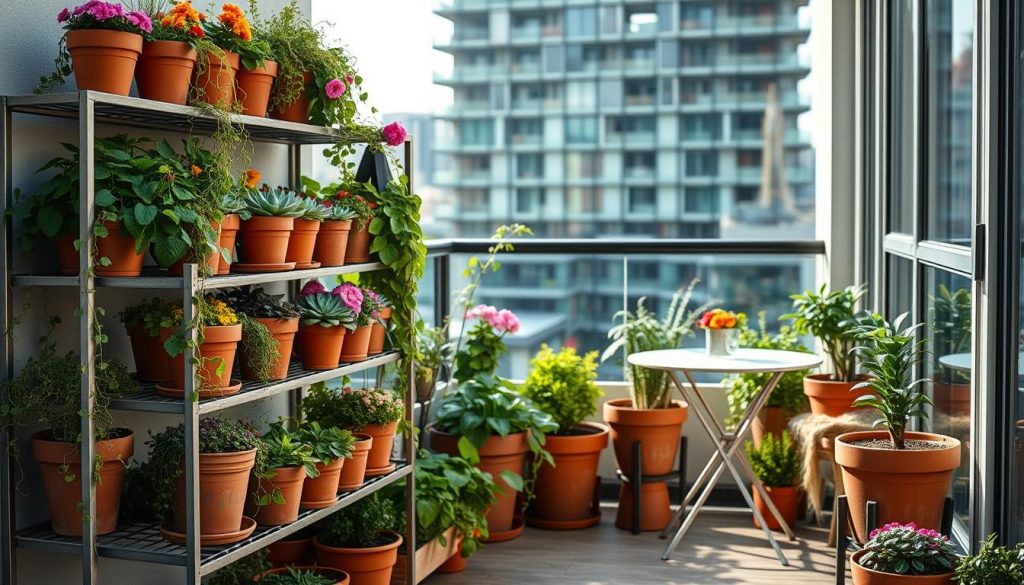
To succeed in container gardening, you need a good plan and to know the basics. With the right steps, even the tiniest balcony can become a lush garden paradise.
Selecting Perfect Containers
Picking the right containers is key for a successful balcony garden. Think about these important points:
- Material durability against weather conditions
- Weight restrictions of balcony structure
- Container size matching plant root requirements
- Drainage capabilities
Soil and Drainage Essentials
The soil mix you choose is vital for your plants’ health. Use a light, nutrient-rich potting soil for good drainage and root growth. Make sure your containers have drainage holes to avoid root rot and keep plants healthy.
Fertilization and Maintenance
Container gardens need regular food to grow well. Use slow-release fertilizers for steady nutrition. Keep an eye on your plants to help them flourish in small spaces.
With the right containers and care, you can turn urban balconies into green, productive spaces.
Sustainable Gardening Tips for Balcony Owners
Urban gardening on balconies is a great way to create eco-friendly spaces. These small areas can become green havens that help both people and the planet.
Balcony gardening lets city folks live green by using smart gardening methods. With the right design and plant choices, they can make amazing sustainable gardens.
Eco-Friendly Plant Choices
Choosing the right plants is key for green balcony gardening. Here are some good picks:
- Native perennial plants that need little care
- Drought-resistant plants that save water
- Plants that help local pollinators
- Organic, non-invasive plants
Composting on Balconies
Composting on balconies can cut down waste and make great soil for gardens. Here are some small composting ideas:
- Sealed bokashi composting systems
- Vermicomposting with small worm bins
- Compact electric composters
Use of Natural Pest Control
For balcony gardening, use natural pest control methods. These methods keep plants safe without harming the environment:
- Introducing beneficial insects
- Using neem oil sprays
- Implementing companion planting strategies
- Creating physical barriers against pests
Sustainable urban gardening turns balconies into lively, eco-friendly spaces. These spaces help protect our environment.
Integrating Decorative Elements with Plants
Balcony gardening turns small outdoor areas into lively spots. Design is key in making an inviting urban garden. It mixes function with beauty. Choosing the right decorative pieces is important for a small garden.
Decorative Pots and Planters
The right containers can make your balcony garden look great. Here are some stylish options for small spaces:
- Ceramic pots with unique glazes
- Metallic planters for a modern look
- Hanging baskets for more space
- Recycled containers for an eco-friendly choice
Lighting Options for Aesthetics
Lighting changes how you enjoy your balcony garden at night. Try these creative lighting ideas:
- Solar-powered string lights
- LED candle lanterns
- Battery-operated garden spotlights
- Decorative solar stake lights
Incorporating Furniture and Accessories
Add furniture and accessories that fit your balcony garden. Choose compact pieces for a cozy spot:
- Foldable bistro sets
- Slim bar-height tables
- Multipurpose storage benches
- Compact outdoor rugs
Your balcony can be a beautiful outdoor space. It’s not just about plants. It’s about creating a cozy spot that shows your style and connects you with nature.
Attracting Wildlife to Your Balcony Garden
Urban gardening turns small spaces into lively ecosystems. Balconies can become safe havens for local wildlife, boosting biodiversity in city centers. By picking the right plants and making welcoming spaces, city folks can draw in helpful insects, birds, and pollinators.
Selecting Pollinator-Friendly Plants
Choosing the right plants for balconies that help wildlife needs careful thought. Some top picks include:
- Lavender – attracts bees and butterflies
- Echinacea – supports multiple pollinator species
- Sedum – provides nectar for various insects
- Native wildflower mixes
Creating a Welcoming Habitat
Balcony gardens can look like natural habitats by adding different plant heights, water, and shelter. Small water features like shallow dishes or bird baths can draw in different wildlife. Native plants are best for supporting local ecosystems.
Maintaining Ecosystem Balance
Successful urban gardening means knowing how wildlife interacts. Stay away from chemical pesticides, use organic fertilizers, and create spaces for different species. Learn about local pollinators and their needs to make a great balcony wildlife garden.
By using these tips, urban gardeners can turn small balcony areas into lively mini-ecosystems. These support local biodiversity.
Troubleshooting Common Balcony Plant Issues
Balcony gardening can be tough, even for experts. It needs careful attention to plant health and the environment. Knowing how to fix problems early is key to success.
Pest and Disease Management
Urban gardens face many pests. Stopping them before they start is crucial. Here are some tips to keep your balcony plants safe:
- Check plants weekly for pests or diseases
- Try natural pest control like neem oil
- Remove sick plants fast to stop the spread
- Keep air moving between containers
Understanding Watering Needs
Watering is critical in balcony gardens. Containers dry out quickly. So, water deeply but not too often to help roots grow strong.
- Use moisture meters for the right amount of water
- Water in the morning or evening
- Make sure containers have holes for water to drain
- Think about using self-watering containers
Dealing with Weather Challenges
Balconies can have extreme weather. Protect your plants from too much sun, wind, and cold. Use smart placement and covers to help.
- Move plants when the weather gets too bad
- Use shade cloths in hot summer days
- Keep containers safe from freezing
- Group plants together for extra protection
Balcony Gardening for Small Children
Urban gardening is a great way to teach kids about plants, even in small areas. By making a child-friendly balcony garden, parents can turn a small outdoor spot into a fun learning place. It helps kids learn and grow in a hands-on way.
Safe Plant Choices for Young Gardeners
When picking plants for kids, safety is key. Here are some safe and fun options:
- Sunflowers: Large, bright, and easy to grow
- Strawberries: Colorful and edible plants
- Snap peas: Quick-growing and interactive
- Marigolds: Robust and visually appealing
Educational Gardening Activities
Urban gardening is a great way to teach kids. Make it fun and educational with these activities:
- Plant growth tracking journals
- Seed planting workshops
- Watering and care responsibilities
- Harvest and cooking experiences
Creating Interactive Spaces
Make your balcony garden fun for kids. Use bright containers and create areas just for them. Add things that kids can touch and explore to make gardening exciting.
Resources and Tools for Balcony Gardening
Urban gardening and balcony gardening are now big in cities for those wanting green spots. To do well in container gardening, you need the right tools, knowledge, and resources. This turns small outdoor spots into lively green places.
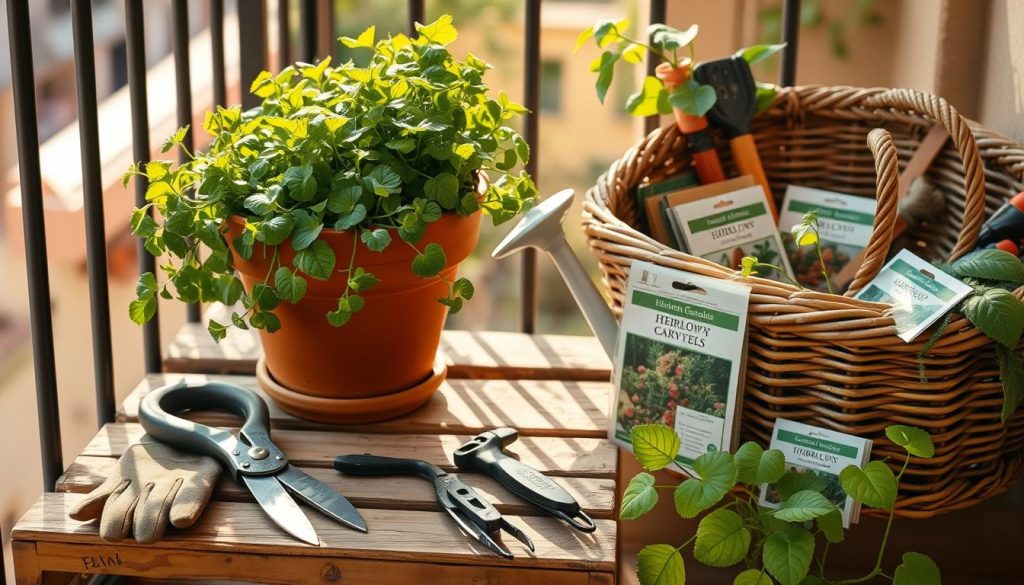
Starting urban gardening might feel hard, but with the right help, anyone can make a great balcony garden. Here are some resources to guide you on your green path.
Recommended Gardening Books
- “The Urban Gardener” by Richard Reynolds
- “Container Gardening Complete” by Jessica Walliser
- “Vertical Gardening” by Derek Fell
Online Gardening Communities
- Reddit’s r/UrbanGardening
- Gardeners’ World Online Forum
- Facebook Balcony Gardening Groups
Essential Gardening Tools
- Lightweight pruning shears
- Compact potting soil scoop
- Collapsible watering can
- Small hand trowel
- Moisture meter
Invest in good tools and resources for a fun and successful balcony gardening journey. These tips will help you grow your urban gardening skills. You’ll make a stunning green space, even in small areas.
Final Thoughts on Choosing the Best Plants for Balconies
Urban gardening has changed how city folks connect with nature. It’s not just about making a balcony look good. It’s about bringing life to small urban spaces. Each balcony garden is a personal haven that connects us to nature.
Exploring urban gardening opens up many chances for green thumbs. Balconies can grow everything from flowers to veggies. Choosing the right plants means knowing your space, sunlight, and what you want to grow.
Future balcony gardening trends include going green and getting creative. Think vertical gardens, smart watering systems, and eco-friendly pots. With a little imagination, you can turn your balcony into a beautiful green oasis.
Start small and keep learning in urban gardening. Your balcony can be a lively spot that makes your home better and helps the planet. Every plant you care for is a step towards a greener city.
